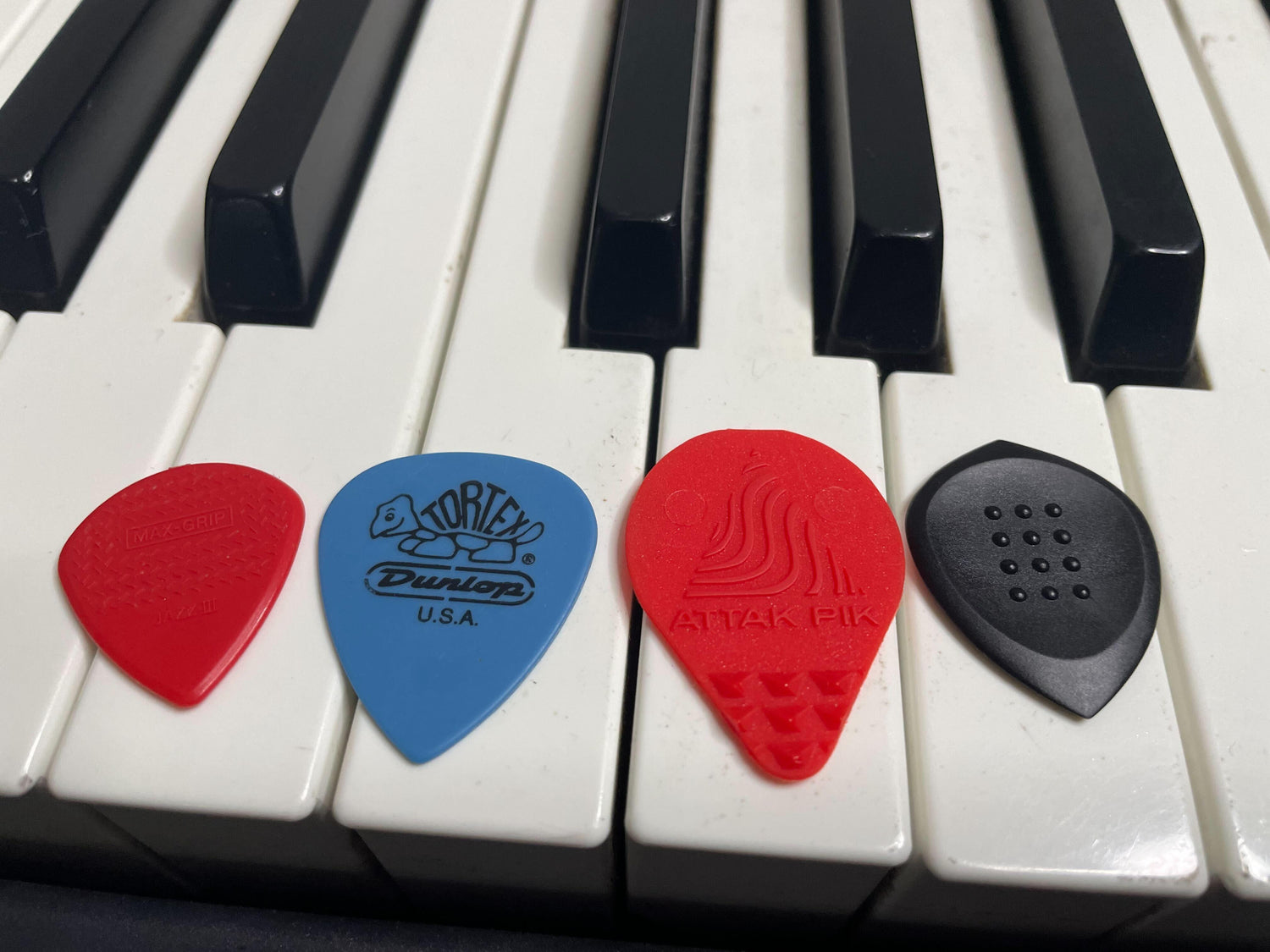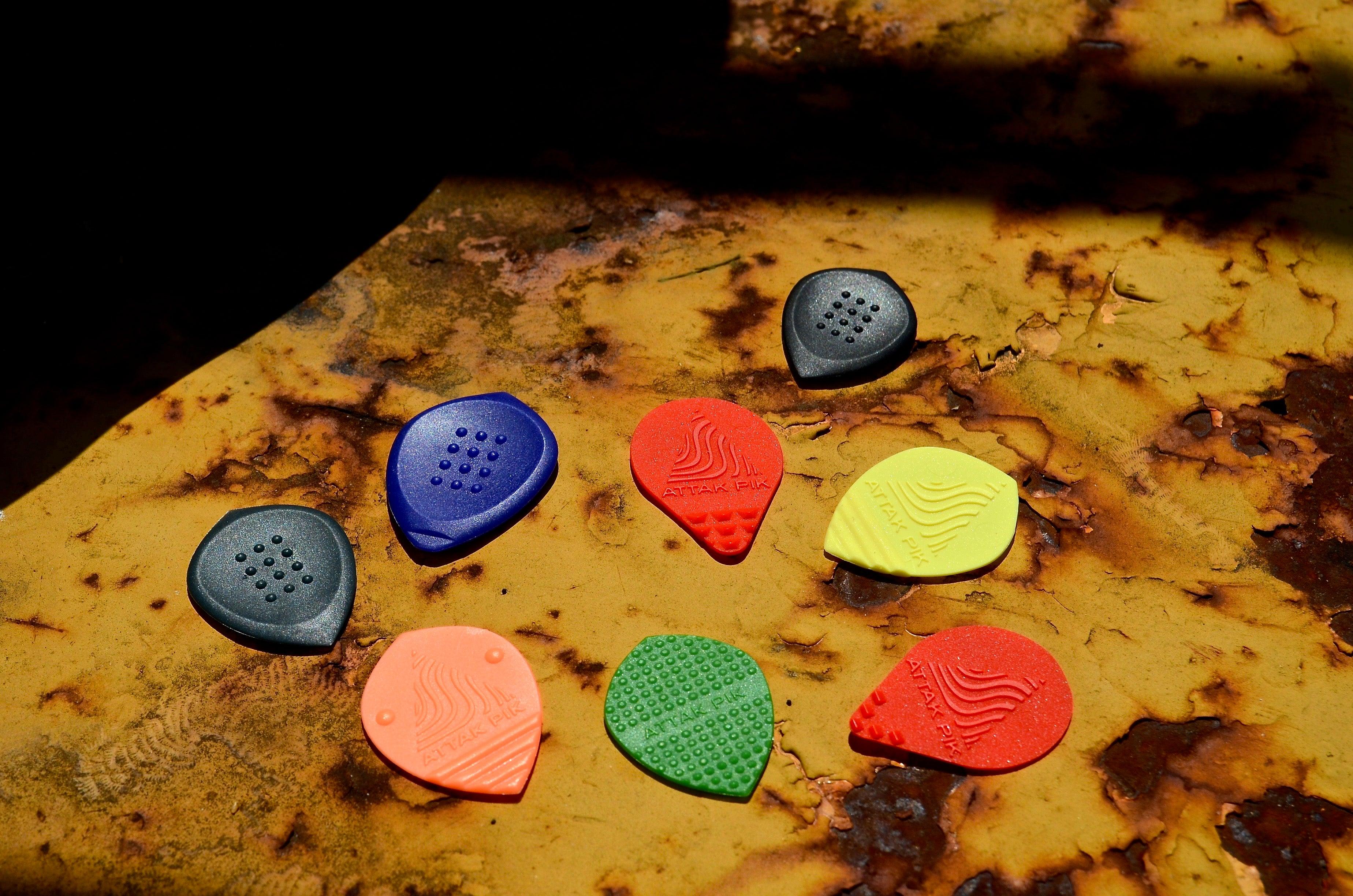Whether it’s a stinging sensation from pressing down on the strings or scratched and scuffed fingernails after hours of pickless strumming, every experienced guitarist can tell you a story about getting or playing their first guitar. These memories of just getting started have a way of imprinting themselves on your body — a guitarist’s growing pains, if you will.
If you’re just starting out, you’re already on the path to making similar memories of your own. Whether those memories are of good guitar playing, however, will largely depend on the quality of your equipment. That’s why it’s essential to know what to look for when choosing the best guitar pick for beginners.
In this blog, we cover all the basics of choosing the right guitar pick for your playing journey, including:

- Guitar Picks 101: A Brief Overview
- Considerations When Choosing the Best Guitar Pick for Beginners
- How to Use a Guitar Pick Properly
- Where to Buy the Best Guitar Picks
Guitar Picks 101: A Brief Overview
A guitar pick is a small, flat piece of material used to play the guitar either by strumming or picking the strings. Guitar picks are important accessories for any guitarist, but there are so many different options out there that it can be hard to know how to choose the best guitar pick for your needs.
Finding the right pick mainly comes down to one important factor: feel. Ultimately, what feels right for you will depend on a combination of elements, such as size, shape, materials, and thickness.
Considerations When Choosing the Best Guitar Pick for Beginners
There are several factors to consider when selecting the right guitar pick for your current experience level, including:
Size & Shape
From squares and rectangles to triangles and teardrops, guitar picks come in many different shapes and sizes, each of which delivers a different tonal effect and compliments a particular playing style.
When it comes to selecting the best guitar pick shape for your playing needs, you really can’t go wrong with old reliable: A triangular teardrop shape. Triangular teardrop picks are fatter at the bottom and taper to a rounded tip. They fit comfortably between the thumb and forefinger, and are easy to maneuver for different strumming and picking techniques.
Playing Comfort
While triangular teardrop guitar picks are great for many beginners, it’s important to consider that comfortability largely depends on the size of the pick relative to the size of your strumming hand. Folks with larger hands or fingers may struggle with smaller picks because they’re easier to drop or fumble.
On the other hand (literally), players with smaller hands may prefer a smaller pick because it closes the distance between their hand and the strings, making it easier to switch between hand techniques like finger picking and palm muting.
Playing Specialty
Your playing specialty also impacts the type of pick you choose. Acoustic guitarists who mainly play rhythm tend to prefer larger picks with a certain amount of flexibility when they strike the strings. This allows them to deliver that distinctive rhythm tone that’s so familiar for folk and country music lovers.
Guitar Pick Materials
The next thing to consider is the type of material used to make the pick. Guitar picks come in a range of different finishes, including wood, metal, celluloid, acrylic, nylon — you name it!
Material choice is largely based on personal preference, but here are some important elements to consider when choosing the best guitar pick for you:
Guitar Pick Thickness
Guitar picks typically come in one of four different gauges, including:
- Thin: 0.40mm to 0.60mm thick
- Medium: 0.60mm to 0.80mm thick
- Thick: 0.80mm to 1.20mm thick
- Extra Thick: 1.20mm+ thick
Thickness impacts the durability of the pick itself as well as the sound it produces. Thin picks are flexible, allowing for faster and more fluid picking techniques. By contrast, thick guitar picks have a more rigid feel and are more durable than their counterparts.
Some guitarists prefer thin picks because they are easier to use when strumming chords while others use thicker, heavier picks that help them dig into the strings for more aggressive playing styles and louder tones. However, you might also consider using two different kinds at once — one for strumming chords and another for picking individual notes or power chords.
How to Use a Guitar Pick Properly
In order to get a nice ringing sound for each chord and note you play, you need to make sure you’re properly positioning your hand and pick relative to the guitar. Here are some things to keep in mind when using a guitar pick:
Guitar Pick Positioning
The first thing you want to do before you start playing is to position the pick correctly in your hand. The most common way of holding a guitar pick is between the thumb and index finger. You want to make sure that the topmost point of the pick protrudes from your hand toward the floor as much as possible while still allowing you to touch the strings easily. This position lets you strum with ease while still being able to control your picking motion with your fingers .
From there, you can try out different playing styles to achieve different sounds. The two basic techniques are strumming and picking.


Strumming
Guitar strumming is the act of hitting multiple strings at once with your fingers or a pick. It’s the most common way to play chords on the guitar and is typically used for rhythm playing in various music styles such as folk, rock, country, and pop.
A strumming pattern is just a series of down- and up-strokes that you play one after the other as you alternate chords. You can do this in different ways, like moving up or down the fretboard, but most guitarists stick to downstrokes when they’re just getting started.
Picking
Picking refers to playing individual notes on the guitar, rather than strumming chords. While this isn’t as mellow as strumming, using a pick to pluck individual strings will produce a nice percussive sound.
Where to Buy the Best Guitar Picks
Choosing a pick that best suits your musical needs is an important element to fully enjoy your guitar playing. Whether you’re a beginner or an advanced player, following the guidelines above should leave you well-equipped to find a pick that’s perfect for you.
If you’re new to playing guitar, Acoustik Attak offers a broad range of guitar picks for players at every experience level. Our guitar picks feature raised structures on their tips, leading to various sound enhancement such as desirable harmonics, tone brightness, and percussive effects. Shop our selection of innovative picks to find the best guitar pick for your current experience level.




Leave a comment
All comments are moderated before being published.
This site is protected by hCaptcha and the hCaptcha Privacy Policy and Terms of Service apply.